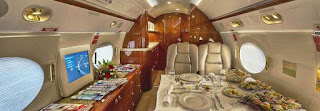The Learjet 31A is similiar to the Learjet 35 which is one of the most popular private jets ever built.
https://centraljetcharter.com/learjet-31a.html
LEARJET 31A, Information!
However, after Bombardier acquired Learjet in 1990, the improved Model 31A was introduced.
The new aircraft featured Honeywell avionics, including a five-tube Bendix EFS-50, a Bendix/King KFC-3100 autopilot, and Bendix Series III radios, plus a Universal UNS-1M flight management system.
Other features included electric windshield deicing, digital nosewheel steering, and a new rudder boost system.
The Learjet 31A received FAA certification in July 1991 and entered service two months later.
A new interior with increased headroom was introduced in 1995, and in 2000 the Learjet 31A’s takeoff and landing weights were increased.
A full-authority digital engine control was added, along with two-zone climate controls. Thrust reversers became standard equipment.
Numerous aftermarket enhancements have been developed for the Learjet 31/31A. Two of the most popular are Raisbeck’s aft fuselage locker and its ZR Lite package.
The locker can store up to 300 pounds of luggage and improves aft fuselage aerodynamics. The ZR Lite system, whose primary element is new trailing-edge flaps.
This helps to increases the fuel efficiency and performance of the aircraft. Another notable improvement is Honeywell’s TFE731-2 to -2C engine upgrade.
When Bill Lear created the Learjet in the early 1960s, he envisioned a small, fast and simple airplane, a concept the marketplace embraced.
His 20-series and the slightly elongated 30-series aircraft that followed sold briskly for more than 20 years, until long after he had left the company.
In the late 1970s, new owner Gates Learjet began work on the bigger, midsize Model 55 that mated the wing of the Learjet Model 28/29 Longhorn with an expanded Model 35 fuselage.
The conglomeration yielded a 70-inch-tall "stand-up" cabin, but it was basically a parts airplane as opposed to a clean-sheet-of-paper design.
Subsequently, Bombardier introduced several other successful models, including the Learjet 40 and 45.
It is currently developing the ambitious, all-composite Learjet 85, an aircraft poised to create a market niche between midsize and super-midsize.
The straight 31s were first out of the gate. They feature antique analog avionics and an alcohol windshield de-icer.
However, the bulk of production was the Model 31A, which began appearing in 1991. The difference between a 31 and a 31A is significant.
In short, the Learjet 31A cuts no corners when it comes to speed, economy, and performance – a great combination.
With this Private Jet Aircraft, an owner can expect great runway performance and lower fuel burn, making it a great candidate for fast and efficient LEARJET 31A.
The Learjet 31A has excellent in-flight performance. Its rapid acceleration and rapid response capabilities make it a favorite among pilots.
This private aircraft is known for its smooth flights and good performance even outside the recommended flight envelope.
LEARJET 31A, Airplane Charter Services!
LEARJET 31A, Information!
However, after Bombardier acquired Learjet in 1990, the improved Model 31A was introduced.
The new aircraft featured Honeywell avionics, including a five-tube Bendix EFS-50, a Bendix/King KFC-3100 autopilot, and Bendix Series III radios, plus a Universal UNS-1M flight management system.
Other features included electric windshield deicing, digital nosewheel steering, and a new rudder boost system.
The Learjet 31A received FAA certification in July 1991 and entered service two months later.
A new interior with increased headroom was introduced in 1995, and in 2000 the Learjet 31A’s takeoff and landing weights were increased.
A full-authority digital engine control was added, along with two-zone climate controls. Thrust reversers became standard equipment.
Numerous aftermarket enhancements have been developed for the Learjet 31/31A. Two of the most popular are Raisbeck’s aft fuselage locker and its ZR Lite package.
The locker can store up to 300 pounds of luggage and improves aft fuselage aerodynamics. The ZR Lite system, whose primary element is new trailing-edge flaps.
This helps to increases the fuel efficiency and performance of the aircraft. Another notable improvement is Honeywell’s TFE731-2 to -2C engine upgrade.
When Bill Lear created the Learjet in the early 1960s, he envisioned a small, fast and simple airplane, a concept the marketplace embraced.
His 20-series and the slightly elongated 30-series aircraft that followed sold briskly for more than 20 years, until long after he had left the company.
In the late 1970s, new owner Gates Learjet began work on the bigger, midsize Model 55 that mated the wing of the Learjet Model 28/29 Longhorn with an expanded Model 35 fuselage.
The conglomeration yielded a 70-inch-tall "stand-up" cabin, but it was basically a parts airplane as opposed to a clean-sheet-of-paper design.
Subsequently, Bombardier introduced several other successful models, including the Learjet 40 and 45.
It is currently developing the ambitious, all-composite Learjet 85, an aircraft poised to create a market niche between midsize and super-midsize.
The straight 31s were first out of the gate. They feature antique analog avionics and an alcohol windshield de-icer.
However, the bulk of production was the Model 31A, which began appearing in 1991. The difference between a 31 and a 31A is significant.
In short, the Learjet 31A cuts no corners when it comes to speed, economy, and performance – a great combination.
With this Private Jet Aircraft, an owner can expect great runway performance and lower fuel burn, making it a great candidate for fast and efficient LEARJET 31A.
The Learjet 31A has excellent in-flight performance. Its rapid acceleration and rapid response capabilities make it a favorite among pilots.
This private aircraft is known for its smooth flights and good performance even outside the recommended flight envelope.
LEARJET 31A, Airplane Charter Services!




The Learjet has extended range.
ReplyDeleteLearjet 31a have a range of 1500 miles.
ReplyDelete